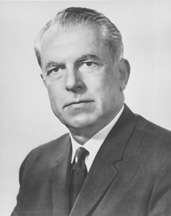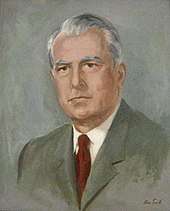Robert Stafford
Robert Theodore Stafford (August 8, 1913 – December 23, 2006) was an American politician from Vermont. In his lengthy political career, he served as the 71st Governor of Vermont, a United States Representative, and a U.S. Senator. A Republican, Stafford was generally considered a liberal, or "Rockefeller" Republican.
Robert Stafford | |
|---|---|
 | |
| United States senator from Vermont | |
| In office September 16, 1971 – January 3, 1989 | |
| Preceded by | Winston L. Prouty |
| Succeeded by | Jim Jeffords |
| Member of the U.S. House of Representatives from Vermont's at-large district | |
| In office January 3, 1961 – September 16, 1971 | |
| Preceded by | William H. Meyer |
| Succeeded by | Richard W. Mallary |
| 71st Governor of Vermont | |
| In office January 8, 1959 – January 5, 1961 | |
| Lieutenant | Robert S. Babcock |
| Preceded by | Joseph B. Johnson |
| Succeeded by | F. Ray Keyser, Jr. |
| 66th Lieutenant Governor of Vermont | |
| In office January 10, 1957 – January 8, 1959 | |
| Governor | Joseph B. Johnson |
| Preceded by | Consuelo N. Bailey |
| Succeeded by | Robert S. Babcock |
| 13th Attorney General of Vermont | |
| In office January 6, 1955 – January 10, 1957 | |
| Governor | Joseph B. Johnson |
| Preceded by | F. Elliott Barber, Jr. |
| Succeeded by | Frederick M. Reed |
| Personal details | |
| Born | Robert Theodore Stafford August 8, 1913 Rutland, Vermont, U.S. |
| Died | December 23, 2006 (aged 93) Rutland, Vermont, U.S. |
| Political party | Republican |
| Spouse(s) | Helen Kelley Stafford (m. 1938-2006, his death) |
| Children | 4 |
| Alma mater | Middlebury College (B.A.) University of Michigan Boston University (LL.B.) |
| Profession | |
| Military service | |
| Allegiance | |
| Branch/service | |
| Years of service | 1942–1971 |
| Rank | |
| Battles/wars | World War II Korean War |
Stafford is best remembered for his staunch environmentalism, his work on higher education, and his support, as an elder statesman, for the 2000 Vermont law legalizing civil unions for gay couples.
Early life
Stafford was born in Rutland, Vermont to Bert Linus Stafford and Mabel R. (Stratton) Stafford.[1] Bert Stafford was a 1901 graduate of Middlebury College who practiced law in Rutland, and was President of the Rutland County National Bank. He served as Rutland County's State's Attorney, and was mayor from 1915 to 1917, President of the Vermont Bar Association in 1930, and Chairman of the Vermont Board of Education.[2][3][4][5][6]
Stafford graduated from Middlebury College in 1935. While there, he joined the Delta Upsilon fraternity. He briefly attended the University of Michigan Law School before earning his LL.B. from the Boston University School of Law in 1938.[7]
Start of career
Upon completing law school, Stafford was admitted to the bar and practiced law with the Rutland firm of Stafford, Abatiell, and Stafford.[8] He became active in politics as a Republican and served as Rutland's grand juror (prosecutor in the municipal court) from 1938 to 1942.[8]
World War II and Navy Reserve service
In 1942, Stafford joined the United States Navy Reserve for World War II and was commissioned as an ensign.[8] Assigned to the Intelligence branch, he completed his initial training at Dartmouth College and at Fort Dix, New Jersey.[8] He then carried out intelligence officer postings at the Navy Department in Washington, D.C. and at Navy bases on Cape Cod, Massachusetts.[8]
Stafford later requested sea duty and served as senior watch officer aboard USS West Point, the Navy's largest troop transport ship.[8] During his service on the West Point, the ship made numerous voyages across the Atlantic to Europe and Africa. Stafford advanced to lieutenant commander during the war, and at its end in 1945 he was the ship's chief transportation officer.[8] He returned to Rutland in February 1946 while continuing to serve in the Navy Reserve.[8]
In October 1951, Stafford returned to active duty during the Korean War era.[9] He was assigned as gunnery officer aboard USS Mission Bay, a Reserve training ship berthed in Bayonne, New Jersey, and served until February 1953.[10][11] He remained in the Navy Reserve after his second deployment and retired at the rank of captain in March 1971.[12]
Continued career
Stafford served as Rutland County's State's Attorney from 1947 to 1951 and practiced law in a new firm, Stafford and LaBrake.[9]
Following his Korean War-era deployment, he entered Vermont statewide politics, serving as Deputy Attorney General for the state from 1953 to 1955, and Attorney General from 1955 to 1957. In 1956, he was elected Lieutenant Governor, and in 1958 was elected Governor.
Stafford's ascent to the lieutenant governorship and governorship was unusual in that he did not follow the path of most Vermont Republicans. From the founding of the party in the 1850s, Republicans in Vermont had made use of the Mountain Rule, which called for candidates for governor and lieutenant governor to alternate between the east and west sides of the Green Mountains, and for governors to serve only two years in office. U.S. Senators were also allocated according to the Mountain Rule, with one from the east and one from the west. Under this system, candidates for governor and lieutenant governor were chosen by the party years in advance, and served in leadership roles in the Vermont General Assembly, including Speaker of the Vermont House of Representatives and President of the Vermont Senate. Stafford is one of Vermont's few governors who did not serve in the legislature. By the late 1950s, the Democratic Party was becoming increasingly competitive in Vermont, and in the 1958 election, Stafford won the governorship over Bernard J. Leddy with only 50.3% of the vote.

In 1960, Stafford was the Republican nominee for Vermont's lone seat in the U.S. House of Representatives, supported by all factions of his party because he was regarded as the strongest challenger to Democrat William H. Meyer, who had broken the Republican Party's 100 year hold on statewide offices by winning election to Congress in 1958. Stafford won, and was subsequently reelected four times, serving in the House from January 3, 1961 to September 16, 1971.[13]
In September 1971, he resigned his seat in the House to accept appointment to the Senate, temporarily filling the vacancy caused by the death of Winston L. Prouty. Stafford won the January 1972 special election to serve out the rest of Prouty's term and won reelection twice including the 1976 election against outgoing Governor Thomas P. Salmon. He served for slightly over 17 years, until his retirement in 1989. He chaired the Committee on Environment and Public Works from 1981 to 1987.
While in Congress, he helped pass a law, now known as the Robert T. Stafford Disaster Relief and Emergency Assistance Act, or Stafford Act, to coordinate federal natural disaster assistance.
Stafford's support of weapons sales to Nicaraguan contras led to the Winooski 44 protest.
As he neared retirement from the Senate, New York Times writer Philip Shabecoff wrote in a profile of Stafford that his tendency to keep his own counsel meant he "may give the worst interview of any public official in the capital." Stafford commented on his own reputation for maintaining a low profile by saying "I talked more when I was younger."[14]
Death and burial
Stafford died in his hometown of Rutland on December 23, 2006.[15] He was buried at Evergreen Cemetery in Rutland.[16] His wife Helen Stafford died February 27, 2011, at the age of 93.[17]
Legacy
In 1988, Congress renamed the Federal Guaranteed Student Loan program the Robert T. Stafford Student Loan program, in honor of his work on higher education.[18]
In 2007, Congress renamed the White Rocks National Recreation Area in the State of Vermont as the "Robert T. Stafford White Rocks National Recreation Area."[19]
References
- "Stafford, Robert Theodore (1913-2006)". The Political Graveyard. Retrieved October 10, 2012.
- Wiley, Edgar J. (1917). Catalogue of Officers and Students of Middlebury College. Middlebury, VT: Middlebury College. p. 338.
- Vermont Legislative Directory. Montpelier, VT: Vermont Secretary of State. 1929. pp. 516, 568.
- Manning's Directory: Rutland City and Township, West Rutland and Proctor. Springfield, MA: H. A. Manning Company. 1936. p. 5.
- The Vermont Bar Journal & Law Digest, Volume 18. Montpelier, VT: Vermont Bar Association. 1992. p. 26.
- Journal of the Senate of the State of Vermont. Montpelier, VT: Capital City Press. 1913. p. 1035.
- "Vermont Governor Robert T. Stafford". National Governors Association. Retrieved October 10, 2012.
- "R. T. Stafford Will Take Office Today as Prosecutor in County". Rutland Daily Herald. Rutland, VT. February 1, 1947. p. 7 – via Newspapers.com.
- "R. T. Stafford is Recalled". Rutland Daily Herald. Rutland, VT. October 19, 1951. p. 6 – via Newspapers.com.
- "Stafford of Rutland May be Deputy Atty. Gen". Burlington Free Press. Burlington, VT. Morning Press Bureau. December 12, 1952. p. 2 – via Newspapers.com.
- "R. T. Stafford is Appointed". Rutland Daily Herald. Rutland, VT. February 5, 1953. p. 7 – via Newspapers.com.
- "Rep. Stafford retires as Captain in Navy Reserve". Bennington Banner. Bennington, VT. March 19, 1971. p. 12 – via Newspapers.com.
- "Sen. Robert Stafford". govtrack.us. Retrieved October 10, 2012.
- Shabecoff, Philip (28 December 1988). "WASHINGTON TALK: THE SENATE; Quiet Vermonter Who Makes His Words Count". New York Times. Retrieved 7 October 2014.
- Sneyd, Ross (December 23, 2006). "Former Vermont Senator Robert Stafford dies at 93". Vermont Seven Days. Burlington, VT. Associated Press.
- "Prominent Burials". Evergreen Cemetery, Rutland. Burlington, VT: Vermont Old Cemetery Association. 2015.
- "Helen Stafford; was widow of Vermont politician; at 93". Boston Globe. Boston, MA. Associated Press. March 1, 2011.
- "Student Loan 101: All About Stafford Loans". The Street Network. Retrieved October 10, 2012.
- "Congressional Record 109th Congress (2005-2006)". The Library of Congress. Retrieved October 10, 2012.
External links
- United States Congress. "Robert Stafford (id: S000776)". Biographical Directory of the United States Congress. Retrieved on 2008-01-26
- Appearances on C-SPAN
- History of the Stafford Federal Student Loan Program
- CNN Obituary for Stafford (inactive)
- Wife of late Vermont US Sen. Stafford dies at 93
- National Governors Association
- Robert Stafford at Find a Grave
- The Political Graveyard

